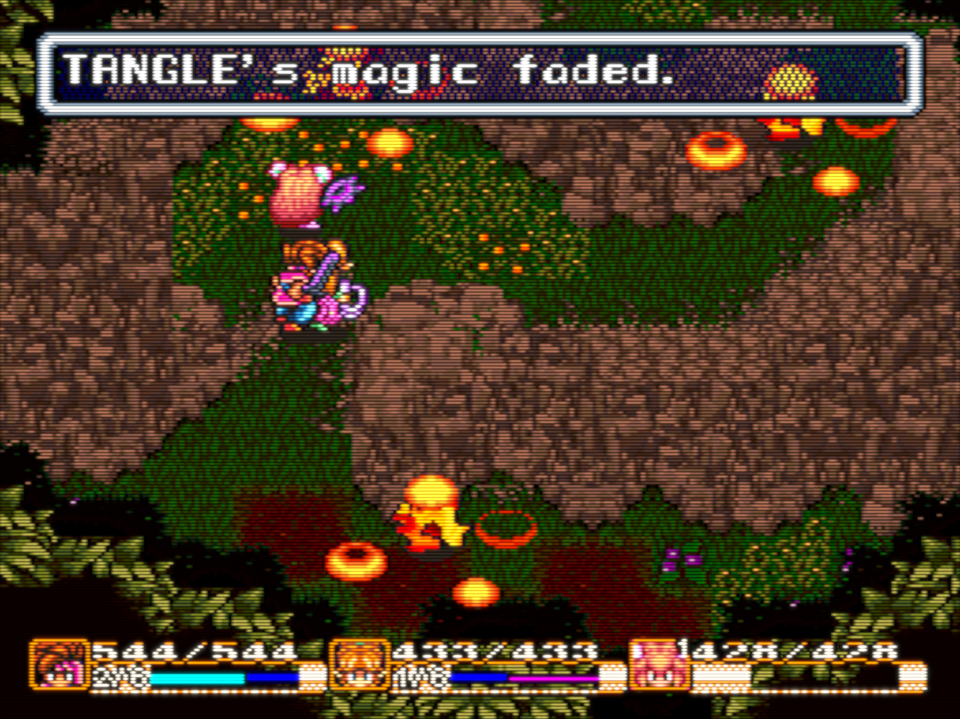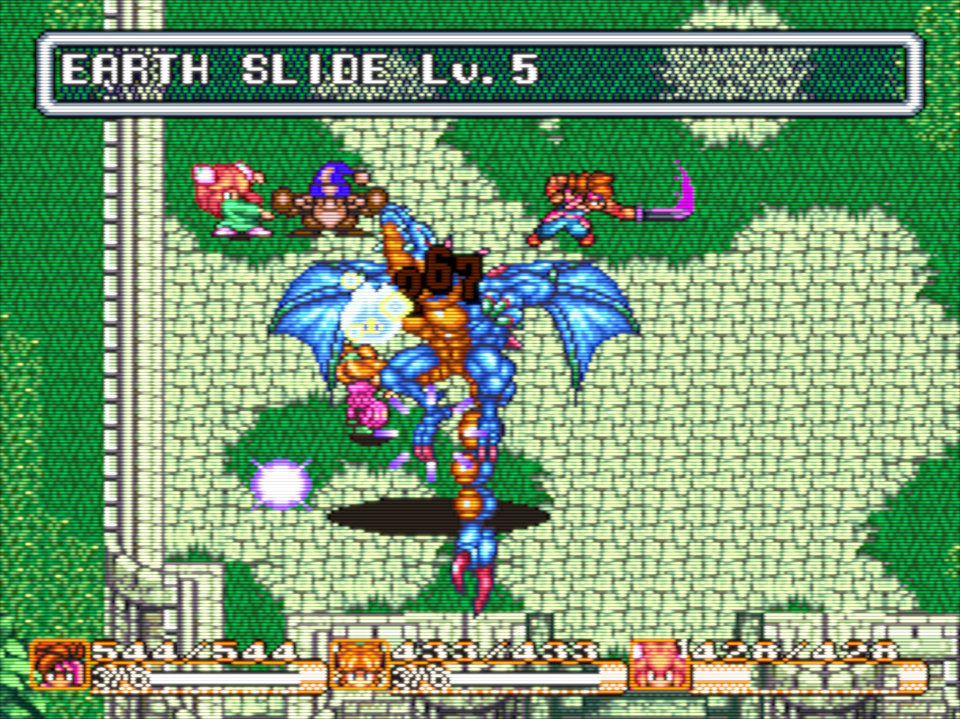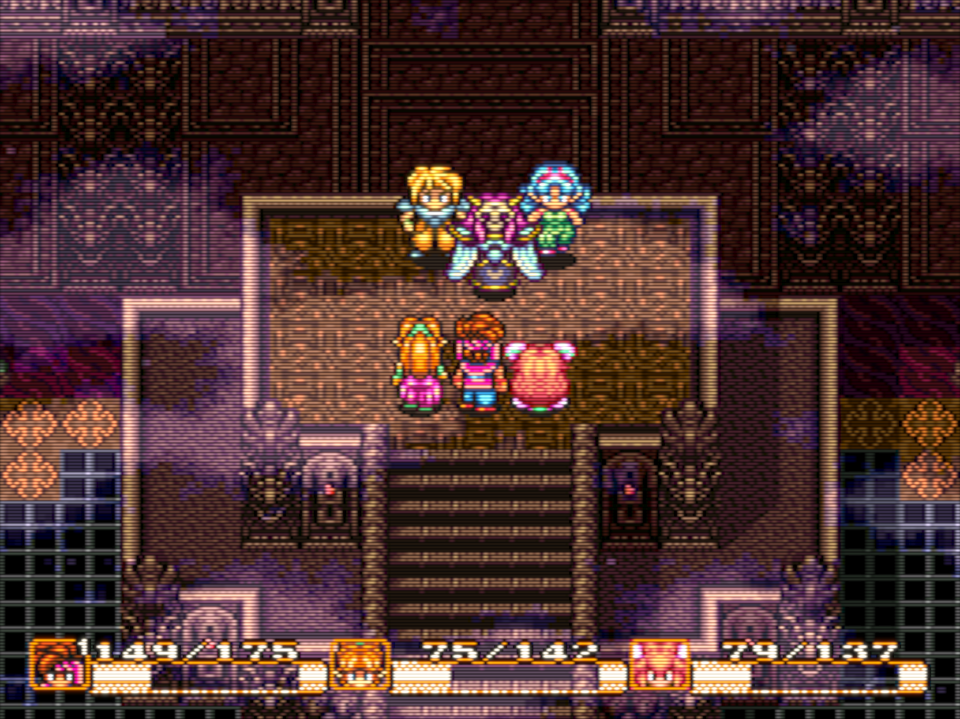Note: the video and the text are the same review. There are additional observations below the text review that are not in the video.
Secret of Mana is going thorough a re-evaluation. It has traditionally been considered one of the best JRPGs or action-adventures on the SNES, and sits near the top of many “Best of” lists.
Today, similar to the classic Sonic the Hedgehog games, people are playing Secret of Mana and coming away with some quizzical looks. “Is this it?”, they are saying. “What’s all the fuss about.”
I don’t think either Sonic or Secret of Mana are getting a fair assessment from these newer players, but as somebody who recently completed Secret of Mana, there were times I wanted to quit, too.

The combat is particularly unpalatable to those of us acclimatised to modern game design. Unlike most action games, you can rarely dodge enemy attacks, and are forced to take them on the chin. You regularly have control taken away from you as you recover from long stun conditions. When you attack, sometimes you hit the enemy, and sometimes you don’t, but it seems to be random, making the player feeling like they aren’t in control. Enemies can be spongy, and if hitting them again and again doesn’t wear on your patience, the pathfinding of your AI companions certainly will.
It seems like textbook “bad game design”, but I want to defend Secret of Mana. It comes back to something I said a moment ago, that Secret of Mana used to be considered a great action-adventure or JRPG. But which is it: an action-adventure or a JRPG? It certainly looks like Zelda and has action-game controls, but as you explore the mechanics you realise it has a lot of mechanical similarities to an ATB system like Final Fantasy IV. You have to wait between each attack for your attack gauge to fill up, and special attacks are chosen from a menu. Looks are deceiving here, but Secret of Mana isn’t really an action game.
In JRPGs combat isn’t enjoyed for the fast-paced skill involved. Rather you enjoy them for some slower paced decision making and, most importantly, the spectacle. In Secret of Mana, When multiple spells are popping off in real-time across the screen — attacks, buffs, heals all at once, from enemies and party members at the same time — you start to see the appeal that Secret of Mana would have had in 1993: of seeing the spectacle of a JRPG battle from a top-down, real-time perspective.

Blowing up an enemy in one magic that hits a weakness never gets old, and though charge attacks take an age to reach full power when they hit, and the big numbers start flying, it’s totally worth it.
It is also worth it because each enemy you kill helps raise your weapon level, and this is where Secret of Mana starts to get a bit addictive.
It starts with weapon orbs, which are found in the world and they are extremely enticing because they allow you to transform your weapon at the blacksmith, which gives more damage, a new charge level, and usually some sort of secondary effect. But you don’t get the benefit of the new weapon until the character has used that weapon type enough. All characters can use all weapons, but they only gain proficiency with whichever ones you use for them, which encourages you to mix up which weapons you use while also creating a uniqueness to your party: in your game, the girl might be proficient with the axe and the bow, in another player’s game, the girl might be proficient with the fist and the whip.
(Your companions don’t have default names in the Western translation. I called the girl Tangle and the spite Brave).
It’s a similar story for magic spells. Spells are grouped by magical spirits as if they were spellbooks: the more you use that spirit’s spells, the more powerful that spirit and its spells become.
Remember that the first mana game was The Final Fantasy Legend, and I find it interesting to consider that in a different timeline, this second mana game might have been “The Final Fantasy Legend 2”, and Udine might have been Shiva, Djinn might have been Ifrit, and so on. That’s just theoretical, but what isn’t theoretical is how these systems make it really rewarding to keep fighting enemies, even when the combat feels a little janky.
Now we’re talking about Final Fantasy, we have to point out that while action adventure games might get away without, JRPGs require a strong story, but Secret of Mana doesn’t have that. It has a handful of characters with a thimbleful of development each. It really lacks the complexity you expect from Square Enix.

But to me, it makes up for it with the world. Maybe not so much in level design — which is fine, nothing special. But in atmosphere and variety? Absolutely yes.
- There is an eerie forest make of crystal.
- There’s a desert town, which seems downtrodden until you return the water, then everyone wants to party like they’re in Dubai.
- There is the mana forest, which haunting, dangerous, and vibrant.
- There’s even a cheery mushroom kingdom. Mario would be proud.
It’s a bit like Mario, actually: it might not have a story, but it has a vibe, and that’s enough to draw you into the worth. I’m fact, I don’t think any JRPG beats Secret of Mana for feeling sunny and adventureful. It comes out in the pixel art… and even more so in the music (composed masterfully by Hiroki Kikuta), which strikes an exceptional balance between chirpy and ethereal, truly appropriate for a light-hearted quest about nature and the threat of losing it. Indeed, that is the one theme that does shine through in Secret of Mana. Particularly at the end of the game, where the hero has a genuine dilemma to face, the one time that the storytelling matches — very, very briefly — the heights of the game’s audiovisual qualities.
This is a bit of an out-there comparison, but Secret of Mana reminds me of Diablo II. A real-time RPG, but not one known for its story or responsive combat mechanics. Rather, one that thrives on a finely tuned atmosphere and a satisfying sense of progression. That’s the lens Secret of Mana deserves to be seen though, and when you do, you realise it deserves to be known as a classic.

Additional observations
Spirit order: Once you get Sylphid, you can learn if an enemy has a magic weakness without trying each type. Before Sylphid, you only have two elements to experiment with. So Sylphid being the third “spellbook” you get access to makes a lot of sense.
The Pure Land difficulty spike: Progression is generally good in this game, but there is one difficulty spike that is handled very poorly. The enemies in the Pure Land hit mega hard, which on one hand is expected: it’s a narratively important area so it feels appropriate that it is dangerous and special. However, the only way to stand up to enemies here is to buy armour that is sold by a single merchant who is easy to overlook. I didn’t even know this armour existed until I looked up a guide, because I assumed I was missing something. This transition was rushed or otherwise underthought.
The shrine pacing: the first few shrines take a long time to get to, but by the time you’ve got four you’re probably ready to get to the end of this quest, so the last four shrines come one after the other in much quicker succession. This might also be an indication that the game was supposed to be longer but the second half was truncated, but in this particular way it works out for the best: it’s fun that the quest speeds up rather than gets dragged out.
Flammie: Flammie is the best airship in a JRPG. He has a button that toggles between top down and from behind views as well as ascend and descend controls in both views. That makes Flammie the airship with the best controls and features in any SNES JRPG?! Also being able to call them from almost anywhere, not having to go to the world map and walk to find it again. He swoops out of the sky and picks you up wherever you are.
The Script Augmentation Project: The fan retranslation released as Secret of Mana: Reborn purportedly clarifies the story and adds events that were not included in the official Western release. As I already feel there is a hint of a great story in the Ted Woolsey script, I’m excited to explore this retranslation further to better understand the Secret of Mana lore, but I haven’t done so yet. Read more about this project on the romhacking.net thread.
Finally, let me leave this game for now by sharing this beautiful collection of Secret of Mana song covers organised by Rebecca Tripp and played by various musicians:
